An exclusive preview of an economic report on China, prepared by the World Bank & government insiders is alarming:
China could face an economic crisis unless it implements deep reforms, including scaling back its vast state-owned enterprises and making them operate more like commercial firms. "China 2030," a report set to be released Monday by the bank & a Chinese government think tank, addresses some of China's most politically sensitive economic issues, according to a half-dozen individuals involved in preparing and reviewing it.
It is designed to influence the next generation of Chinese leaders who take office starting this year, these people said. And it challenges the way China's economic model has developed during the past decade under President Hu Jintao, when the role of the state in the world's 2nd largest economy has steadily expanded.
The report warns that China's growth is in danger of decelerating rapidly & without much warning. That is what has occurred with other highflying developing countries, such as Brazil and Mexico, once they reached a certain income level, a phenomenon that economists call the "middle-income trap." A sharp slowdown could deepen problems in the Chinese banking & elsewhere, the report warns, and could prompt a crisis, according to those involved with the project. It recommends that state-owned firms be overseen by asset-management firms, say those involved in the report. It also urges China to overhaul local government finances and promote competition and entrepreneurship. The Chinese government must decide "whether it wants state-led capitalism dominated by giant state-owned corporations or free-market entrepreneurship."
Current forecasts by the Conference Board, a U.S. think tank, see the Chinese economy growing 8% in 2012 & slowing to an average annual growth rate of 6.6% from 2013 to 2016. Economists argue that China's annual growth rate will begin to "downshift" by at least 2% points starting around 2015. While some reduction in growth is inevitable—China has been growing at an average of 10% a year for 30 years—the rate of decline matters greatly to the world economy. With Europe & Japan fighting recession and the U.S. experiencing a weak recovery, China has become the most reliable source of growth globally. Commodity producers count on China for growth, as do capital goods makers, farmers and fashion brands in the U.S. and Europe.
How much the report will help reshape the Chinese economy is unclear. Even ahead of its release, it has generated fierce resistance from bureaucrats who manage state enterprises, according to several individuals involved in the discussions. China's political heir apparent, Xi Jinping, now vice president, has given few clues about his economic policies. Analysts expect the high-profile report will encourage Mr. Xi and his allies to discuss making changes to a state-led economic model that has alarmed Chinese private entrepreneurs while creating tension between China and its main trading partners, including the U.S.
Currently, state-managed enterprises tower over the Chinese economy, dominating the nation's energy, natural resources, telecommunications and infrastructure industries. Among other things, they have easy access to low-interest loans from state-owned banks.
China needs to restrict the roles of the state-owned enterprises, break up monopolies, diversify ownership and lower entry barriers to private firms. Currently, many state-owned firms have real-estate subsidiaries, which tend to bid up prices for land, and have helped to create a housing bubble that the Chinese government is trying to deflate. The report also recommends a sharp increase in the dividends that state companies pay to their owner—the government. That would boost government revenue and pay for new social programs, said those involved with the report. Chinese and U.S. economists say that dividend money from profitable state-owned firms now is often directed to unprofitable ones by the State-owned Assets Supervision and Administration Commission, or SASAC, which regulates the firms and tries to ensure their profitability.
China is vulnerable to a sharp slowdown, said Jun Ma, a Deutsche Bank China economist, because it relies too heavily on industries that copy foreign technology and doesn't produce enough breakthroughs of its own. South Korea was able to keep growing rapidly after it hit a per-capita income level of $5,000—about where China is today—because it pushed innovation. However, China lags behind South Korea badly in patents produced per capita, he said.
Chinese local governments often draw much of their revenue from the sale of land, rather than from taxes. The report urges that Chinese social spending be funded more by dividends from state-owned firms and by property, corporate and other taxes.
China could face an economic crisis unless it implements deep reforms, including scaling back its vast state-owned enterprises and making them operate more like commercial firms. "China 2030," a report set to be released Monday by the bank & a Chinese government think tank, addresses some of China's most politically sensitive economic issues, according to a half-dozen individuals involved in preparing and reviewing it.
It is designed to influence the next generation of Chinese leaders who take office starting this year, these people said. And it challenges the way China's economic model has developed during the past decade under President Hu Jintao, when the role of the state in the world's 2nd largest economy has steadily expanded.
The report warns that China's growth is in danger of decelerating rapidly & without much warning. That is what has occurred with other highflying developing countries, such as Brazil and Mexico, once they reached a certain income level, a phenomenon that economists call the "middle-income trap." A sharp slowdown could deepen problems in the Chinese banking & elsewhere, the report warns, and could prompt a crisis, according to those involved with the project. It recommends that state-owned firms be overseen by asset-management firms, say those involved in the report. It also urges China to overhaul local government finances and promote competition and entrepreneurship. The Chinese government must decide "whether it wants state-led capitalism dominated by giant state-owned corporations or free-market entrepreneurship."
Current forecasts by the Conference Board, a U.S. think tank, see the Chinese economy growing 8% in 2012 & slowing to an average annual growth rate of 6.6% from 2013 to 2016. Economists argue that China's annual growth rate will begin to "downshift" by at least 2% points starting around 2015. While some reduction in growth is inevitable—China has been growing at an average of 10% a year for 30 years—the rate of decline matters greatly to the world economy. With Europe & Japan fighting recession and the U.S. experiencing a weak recovery, China has become the most reliable source of growth globally. Commodity producers count on China for growth, as do capital goods makers, farmers and fashion brands in the U.S. and Europe.
How much the report will help reshape the Chinese economy is unclear. Even ahead of its release, it has generated fierce resistance from bureaucrats who manage state enterprises, according to several individuals involved in the discussions. China's political heir apparent, Xi Jinping, now vice president, has given few clues about his economic policies. Analysts expect the high-profile report will encourage Mr. Xi and his allies to discuss making changes to a state-led economic model that has alarmed Chinese private entrepreneurs while creating tension between China and its main trading partners, including the U.S.
Currently, state-managed enterprises tower over the Chinese economy, dominating the nation's energy, natural resources, telecommunications and infrastructure industries. Among other things, they have easy access to low-interest loans from state-owned banks.
China needs to restrict the roles of the state-owned enterprises, break up monopolies, diversify ownership and lower entry barriers to private firms. Currently, many state-owned firms have real-estate subsidiaries, which tend to bid up prices for land, and have helped to create a housing bubble that the Chinese government is trying to deflate. The report also recommends a sharp increase in the dividends that state companies pay to their owner—the government. That would boost government revenue and pay for new social programs, said those involved with the report. Chinese and U.S. economists say that dividend money from profitable state-owned firms now is often directed to unprofitable ones by the State-owned Assets Supervision and Administration Commission, or SASAC, which regulates the firms and tries to ensure their profitability.
China is vulnerable to a sharp slowdown, said Jun Ma, a Deutsche Bank China economist, because it relies too heavily on industries that copy foreign technology and doesn't produce enough breakthroughs of its own. South Korea was able to keep growing rapidly after it hit a per-capita income level of $5,000—about where China is today—because it pushed innovation. However, China lags behind South Korea badly in patents produced per capita, he said.
Chinese local governments often draw much of their revenue from the sale of land, rather than from taxes. The report urges that Chinese social spending be funded more by dividends from state-owned firms and by property, corporate and other taxes.
Shares of Anil Agarwal-led Vedanta group company Sterlite Industries and Sesa Goa are in News .
Here are few reasons/Views behind the Restructuring of the stocks.
1) Lack of clarity about a restructuring exercise: Media reports indicate that Vedanta Resources (VED) may restructure holdings in group companies. "Vedanta's stated strategy is to simplify and consolidate its corporate structure. Management reviews options to deliver this strategy on an ongoing basis and will update the market as appropriate," the company has said in a statement.
2) Restructuring per se will not impact valuations of the VED Group but valuations assigned to various assets will determine whether value stays at Sterlite or shifts to the parent company, brokerage firm Kotak said in a report. Citing media reports, Kotak says three restructuring scenarios are possible.
3) Vedanta may merge Sesa Goa with Sterlite: Sterlite is reportedly in talks with the government to acquire 49 per cent stake in Balco and 26 per cent stake in Hindustan Zinc (HZ). Sterlite does not have sufficient assets to fund this acquisition. Sesa's cash flow and the debt leverage it can provide can potentially aid acquisition of HZ stake and Balco stake. Such a scenario is neutral at a fair merger ratio, Kotak says. Besides, this might indicate lack of avenues for strategic utilization of Sesa's cash, the brokerage firm adds.
4) Merger of Sesa Goa and complete ownership of Vedanta Aluminium (VAL). This could be negative in case Sterlite has to assume the entire debt of VAL. Fair value impact in such a case could be Rs. 35 per share, Kotak says.
5) Sterlite becomes the holding company for all VED assets excluding KCM: Negative if Sterlite assumes VAL's entire debt. "We compute impact of Rs. 40 per share on Sterlite's fair value with the assumption of (1) merger ratio of 1:2 between Sterlite and Sesa Goa, ratio of market price before speculation of restructuring, (2) acquisition of 40% stake of VED in Cairn India at CMP of Rs390/share and (3) Sterlite assumes VAL's entire debt and does not pay equity value," Kotak says.
6) This value shift can be prevented if (1) VED assumes part of the debt (even if it transfers the entire ownership in VAL), or (2) compensates Sterlite through a favorable merger ratio of Sesa, though Sesa shareholders may object, or (3) sells its stake in Cairn India at a discount to the market price to ensure that Sterlite's minorities are not impacted by any restructuring plan, the brokerage firm adds.
7) Of particular note will be whether value shifts from Sterlite to VED or stays with Sterlite, Kotak notes. This will be determined by the valuation exercise for VAL, a company with combined debt (internal and external) of US$5.5 billion but EBITDA potential of US$200-300 million (without bauxite and captive coal).
8) The Ministry of Environment and Forests rejected VAL's application for the bauxite mine and stopped the expansion phase of the alumina refinery. This has impacted the existing operations and expansion projects. It has a highly leveraged balance sheet (Rs. 276 billion of debt at the end of December 2011 and is essentially surviving on corporate guarantees given by VED and Sterlite. It is difficult to be sanguine on VAL's operations.
10) The management has highlighted its intent to resolve equity holding of Vedanta by March 2012. Dual listing structure is in the offing. Expected structure reduces risk for Sterlite. Merger ratios scenario analysis indicates Sterlite is well below worst case, Macquarie said in its report.
MARK COLVIN: The International Monetary Fund says the world economy is in danger of another 1930s crash.
It would see countries defaulting on their debt and widespread panic on global financial markets.
The IMF forecast came after European finance ministers failed to reach a debt restructuring agreement with private bond holders in Greece last night.
As David Taylor reports there are now just weeks remaining before Greece's economy reaches the point of no return.
DAVID TAYLOR: European finance leaders are running out of time. Last night saw yet another failure of European ministers to negotiate a plan to keep private bond holders at bay.
Key figures from the leadership team commissioned to solve the crisis are no longer shy about where they see things are headed.
CHRISTINE LAGARDE: We could easily, easily, slide into what we call a 1930s moment. A moment where trust and cooperation break down and countries turn inward. A moment ultimately leading to a downward spiral that could very much engulf the entire world.
DAVID TAYLOR: International Monetary Fund managing director Christine Lagarde.
But they're not giving up without a fight.
CHRISTINE LAGARDE: I believe that we can avoid such a scenario. I say this for a simple reason; because we know what must be done.
DAVID TAYLOR: That includes increasing the size of the massive European bailout fund and imposing fire walls around the more robust European economies to prevent financial contagion, a financial contagion that could eventuate if Greece suffers a disorderly default on its debt.
At this point, that's exactly where we are headed.
Last night a group representing private Greek investors met with finance ministers to negotiate new terms for their holdings.
The authorities need the investors to accept some pretty dismal returns on their investments, huge losses to be exact. Understandably they're reluctant to do that but they may have no choice.
Russell Jones is the global head of fixed income strategy at the Westpac Bank.
RUSSELL JONES: To allow that to happen you have to have an interest rate which is comfortable for them. If it's too high, quite simply they will default on their bonds, they won't pay anybody back anything and that's not what the authorities want.
DAVID TAYLOR: But as investors walked away from the negotiating table last night, they increased the chance they'll receive absolutely nothing. That's because Greece is unlikely to receive any more aid money if it's unable to strike a deal with those debt investors. That would leave Greece facing complete financial collapse by the end of March.
RUSSELL JONES: There has to be something done by around the third week in March because at that stage the Greeks have got a very large payment that they have to make.
So that is the absolute deadline for any negotiations on this issue. And clearly they would like to have something in place somewhere before that if they possibly could.
DAVID TAYLOR: And if they don't meet that deadline Greece defaults?
RUSSELL JONES: Greece defaults and not in an orderly way, in a very disorderly way. And the danger with that is it sparks another round of very bad contagion to other countries in the euro zone. They get tarred with the same sort of brush as Greece. It could be a very, very difficult period for financial markets.
DAVID TAYLOR: Fact is strategists at this point are genuinely uncertain about what lies ahead.
RUSSELL JONES: We haven't had a default in a major industrial nation since the Second World War. This is not something we're very used to. It's not something that policy makers are necessarily comfortable with. In fact they're very uncomfortable with it. We don't know what the connotations will be. It's a very uncertain process.
DAVID TAYLOR: What is certain however is what investors are looking for Greece to achieve in the next 10 years, if of course it can make it through the next couple of months.
Berenberg Bank senior economist Christian Schulz.
CHRISTIAN SCHULZ: Is Greece going to be able to regain competitiveness within the euro? Is Greece going to have a sustainable debt level after 2020?
DAVID TAYLOR: Questions that wouldn't carry so much weight if much of the euro zone wasn't dependent on Greece's ultimate economic survival.
The fear is if Greece falls, other, larger economies like Italy will also bite the dust; a scenario nobody can afford.
The IMF will release its latest world growth figures later tonight – figures economists will analyse very closely.
Eurozone crisis live: Greek deal on knife edge
9.01am: Spain has just released GDP figures for the fourth quarter and 2011. Its economy shrank by 0.3% between October and December from the previous quarter (following zero growth in the third quarter), and grew by 0.7% over the year as a whole.
The Bank of Spain also estimates that the economy will contract by 1.5% this year, and return to meagre growth of just 0.2% in 2013.
8.47am: Reuters is reporting that EU ambassadors have agreed to impose an embargo on Iranian oil imports, but decided to postpone the full implementation of the ban until 1 July. The news agency cited a senior EU diplomat.
The EU's 27 foreign ministers, who are meeting in Brussels today, still have to formally approve the ban. EU governments will have to stop signing new contracts with Tehran as soon as the ban is in place, but will be able to fulfill existing contracts until 1 July.
8.43am: The Footsie is now up nearly 20 points at 5749, a 0.3% rise. On the continent, shares have also edged higher, with the Dax in Frankfurt up 5 points and the CAC in Paris 12 points ahead. The euro is trading around $1.2925. Markets are nervous ahead of the eurozone finance ministers' meeting in Brussels, with a Greek debt deal shrouded in uncertainty.
8.26am: Today's meeting of eurozone finance ministers in Brussels has a very full agenda to consider, says Michael Derks, chief strategist at FxPro.
There is the latest draft of the fiscal compact to discuss, a review of the progress made in the Greek debt talks, and a conversation on a draft for the European Stability Mechanism (ESM). The latter apparently includes collective action clauses, although any debt write-offs will need to comply with IMF standards. Germany and France are both keen to wrap up the ESM issue as soon as possible, although it can only take effect once it has been ratified by those countries representing 90% of its capital. It is unlikely that any of these issues will be fully resolved at this meeting, although some progress will be made.
Interestingly, these days the single currency is setting less store in meetings such as these, in sharp contrast to those held in the final quarter of last year. After threatening $1.30 at one stage early on Friday, the euro drifted back to near $1.29.
8.07am: Brent crude futures were steady around $110 a barrel this morning, as concerns about European demand were outweighed by fears over supply disruptions from the Middle East.
Eurozone finance ministers meeting in Brussels today will discuss what terms of a Greek debt restructuring they are ready to accept as part of a second bailout package for Athens.
The debt swap discussions with private creditors have been aimed at reducing Greek's debt to 120% of GDP, from around 160% of GDP. Without a second bailout Greece will not be able to pay back €14.5 bn of maturing bonds in March, which would likely trigger a messy default and could plunge the eurozone into disarray.
EU governments are also expected to agree new economic sanctions against Iran over its nuclear programme today.
Ben Le Brun, market analyst at OptionsXpress, told Reuters:
Both of these meetings are going to be crucial in dictating oil prices. Any indication of a plan getting approved to tackle Greece's debt would support oil. An Iranian oil embargo would also boost prices as demand continues to improve.
8.04am: The FTSE 100 index in London has opened more than 10 points higher at 5739, a 0.2% gain.
Many Asian markets – China, Hong Kong, Singapore and South Korea – were closed for the Lunar New Year holiday. Stock markets that were open for business were mixed, amid light volumes. Japan's Nikkei was flat at 8,765.90.
7.59am: The main event today is the meeting of EU finance ministers this afternoon. Here's today's agenda:
• Franco-German finance and economy council meets in Paris. Press
conference – 10.15am GMT (11.15am CET)
• Eurozone consumer confidence of January – 3pm GMT
• European finance ministers meet in Brussels – 4pm GMT (5pm CET)
• Christine Lagarde gives speech on 2012′s economic challenges -
5.30pm GMT (6.30pm CET)
Bond auctions
• Germany to sell €3bn of 12-month bonds – 10.15am GMT
• France to sell up to €8.3bn of Treasury bills – 1.50pm GMT
7.30am: Good morning and welcome back to our rolling coverage of the world economy and eurozone debt crisis. Hopes of a deal in Greece with private bondholders in time for the eurozone finance ministers' meeting have dwindled after the bondholders' representative, Charles Dallara, managing director of the Institute of International Finance, left Athens on Saturday.
Creditors have made their 'best offer,' and are not willing to take any more than a 65% to 70% loss on the current value of Greek debt (with a coupon of 4%-4.5%, while the IMF has indicated it wants a coupon closer to 3%).
Even that wouldn't be anywhere near enough to tackle Greece's mounting debt burden, says Michael Hewson, market analyst at CMC Markets.
Let's not forget that we started out at a 21% haircut at last July's EU summit and the number has kept going up, at the same rate that Greece's economy has been spiralling down.
It remains unlikely that a deal will be reached by the end of today's EU finance ministers' summit, as originally hoped. Even so Greek officials remain confident that a deal can be reached by the next EU summit on 30th January but time is short, given the deadline of a €14.5bn bond repayment in March.
European Union ambassadors agreed on Monday to impose an embargo on crude oil imports from Iran, to be phased in by July 1. EU foreign ministers are expected to approve the measure later in the day.
Following are key facts about prior EU sanctions against Iran and economic relations between the bloc's 27 states and OPEC's second largest producer.
EXISTING SANCTIONS
The EU has gradually imposed sanctions on Iran since 2007 as part of Western efforts to put pressure on Tehran over its nuclear work. Sanctions include those agreed by the United Nations and autonomous EU measures. Current EU sanctions include:
- Trade ban on arms and equipment that can be used for repression, and a ban on goods and technology related to nuclear enrichment or nuclear weapons systems, including nuclear materials and facilities, certain chemicals, electronics, sensors and lasers, navigation and avionics;
- Ban on investment by Iranian nationals and entities in uranium mining and production of nuclear material and technology within the EU;
- Ban on trade in dual-use goods and technology, for instance telecommunication systems and equipment; information security systems and equipment; nuclear technology and low-enriched uranium;
- Export ban on key equipment and technology for the oil and gas industries (ie exploration and production of oil and natural gas, refining and liquefaction of natural gas). Ban on financial and technical assistance for such transactions. This includes geophysical survey equipment, drilling and production platforms for crude oil and natural gas, equipment for shipping terminals of liquefied gas, petrol pumps and storage tanks;
- Ban on investment in the Iranian oil and gas industries (exploration and production of oil and gas, refining and liquefaction of natural gas). This means no credits, loans, new investment in and joint ventures with such companies in Iran;
- Ban on new medium- or long-term commitments by EU member states to financial support for trade with Iran. Restraint on short-term commitments;
- EU governments are banned from extending grants and concessional loans to the Iranian government. Provision of insurance and re-insurance to the Iranian government and Iranian entities (except health and travel insurance) is banned;
- EU financial institutions must report to national authorities any transactions with Iranian banks they suspect concern proliferation of financing; banks must notify transfers above 10,000 euros to national authorities and request prior authorization for transactions above 40,000 euros (with humanitarian exemptions);
- Iranian banks are banned from opening branches and creating joint ventures in the EU; EU financial institutions are banned from opening branches or bank accounts in Iran;
- Ban on the issuance of and trade in Iranian government or public bonds with the Iranian government, central bank and Iranian banks;
- EU governments must require their nationals to exercise vigilance over business with entities incorporated in Iran, including those of the Iranian Revolutionary Guard Corps and of the Islamic Republic of Iran Shipping Lines;
- National customs authorities must require prior information about all cargo to and from Iran. Such cargo can be inspected to ensure trade restrictions are respected;
- Cargo flights operated by Iranian carriers or coming from Iran may not have access to EU airports (except mixed passenger and cargo flights). No maintenance services to Iranian cargo aircraft or servicing to Iranian vessels may be provided if there are suspicions that it carries prohibited goods;
- Visa bans are imposed on persons designated by the UN or associated with or providing support for Iran's proliferation-sensitive nuclear activities or for the development of nuclear weapon delivery systems, and on senior members of the IRGC; as of January 22, visa bans and asset freezes apply to 113 persons (41 designated by the UN and the rest by the EU);
- Asset freeze on 433 entities associated with Iran's proliferation-sensitive nuclear activities or the development of nuclear weapon delivery systems; and senior members and entities of IRGC and the IRISL (UN designations cover 75 entities); these entities include: companies in banking and insurance sectors, the nuclear technology industry and in the field of aviation, armament, electronics, shipping, chemical industry, metallurgy, the oil and gas industry, and branches and subsidiaries of IRGC and IRISL.
HUMAN RIGHTS
In addition to the nuclear track, the EU has imposed travel bans and asset freezes on 61 Iranians seen as responsible for human rights violations.
ECONOMIC RELATIONS
The EU had a free-trade agreement with Iran until 2005 and Tehran's refusal to cooperate with the IAEA on its nuclear work. Europe remains an important trade partner. Ninety percent of EU imports from Iran are either oil or oil-related products. In 2010, the EU imported 14.5 billion euros worth of goods from Iran and exported 11.3 billion euros of goods to it.
All Central Bank Balance Sheets Are Exploding Higher, Or Engaged In QE
The degree to which central banks around the world are printing money is unprecedented.
The first eight charts below show the balance sheets of the largest central banks in the world. They are the European Central Bank (ECB), the Federal Reserve (Fed), the Bank of Japan (BoJ), the Bank of England (BoE), the Bundesbank (Germany), the Banque de France, the People's Bank of China (PBoC) and the Swiss National Bank (SNB). Noted on the charts are significant events or growth rates.
Shown is the size of each respective balance sheet in its local currency. Note that all are exploding higher as every chart goes from the lower left to the upper right. Most are still making new all-time highs. If the basic definition of quantitative easing (QE) is a significant increase in a central bank's balance sheet via increasing banking reserves, then all eight of these central banks are engaged in QE.
>
Click to enlarge:

˜˜˜
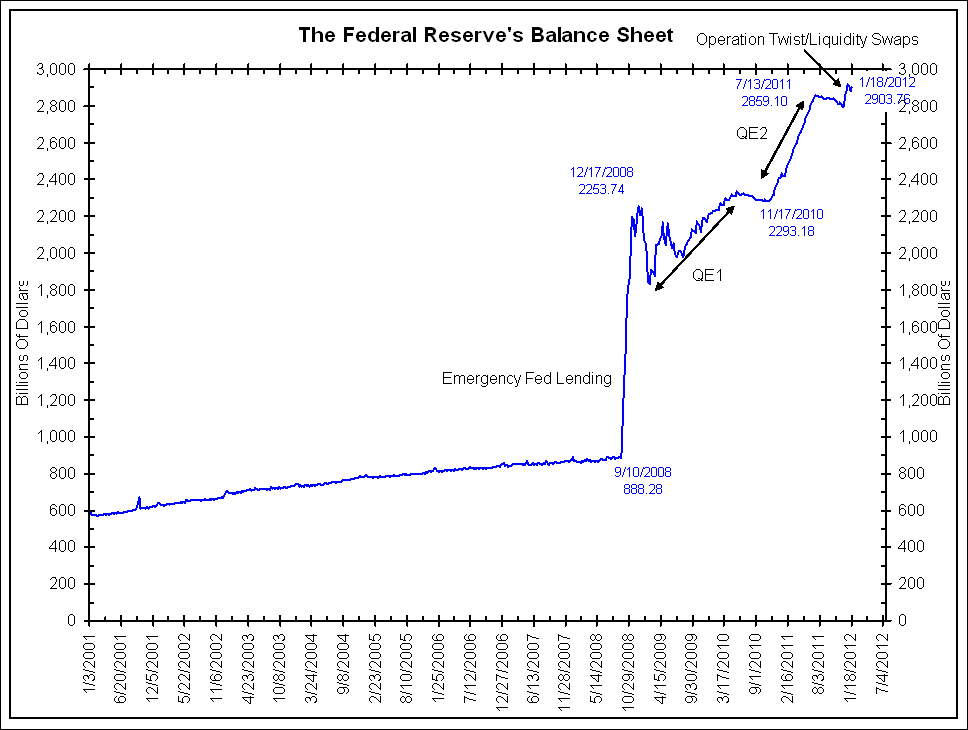
˜˜˜

˜˜˜

˜˜˜

˜˜˜
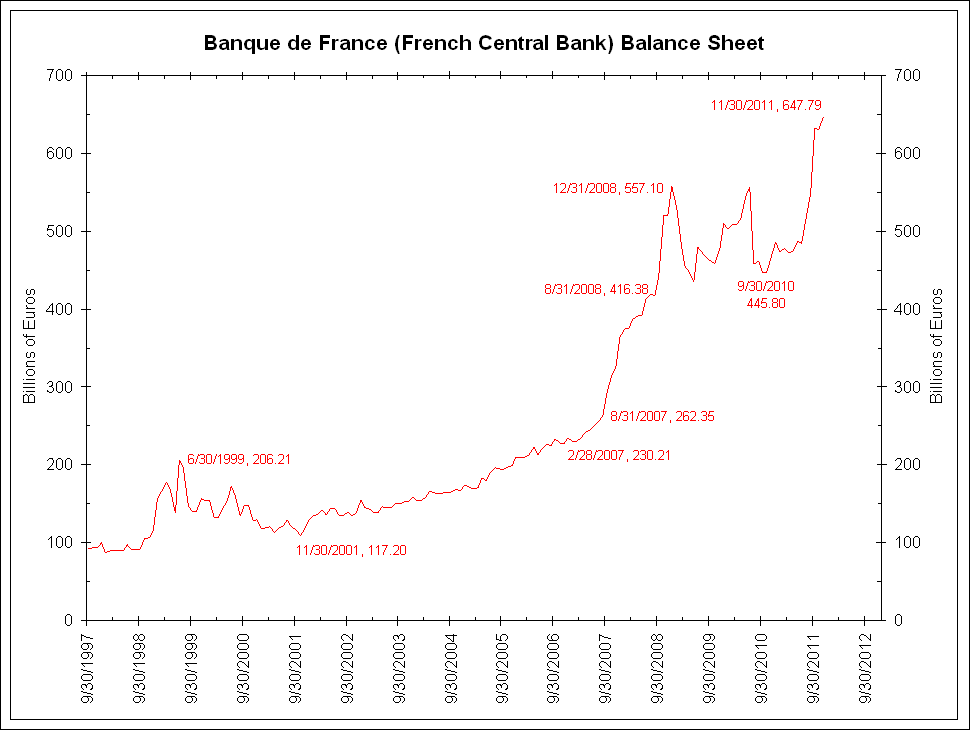
˜˜˜
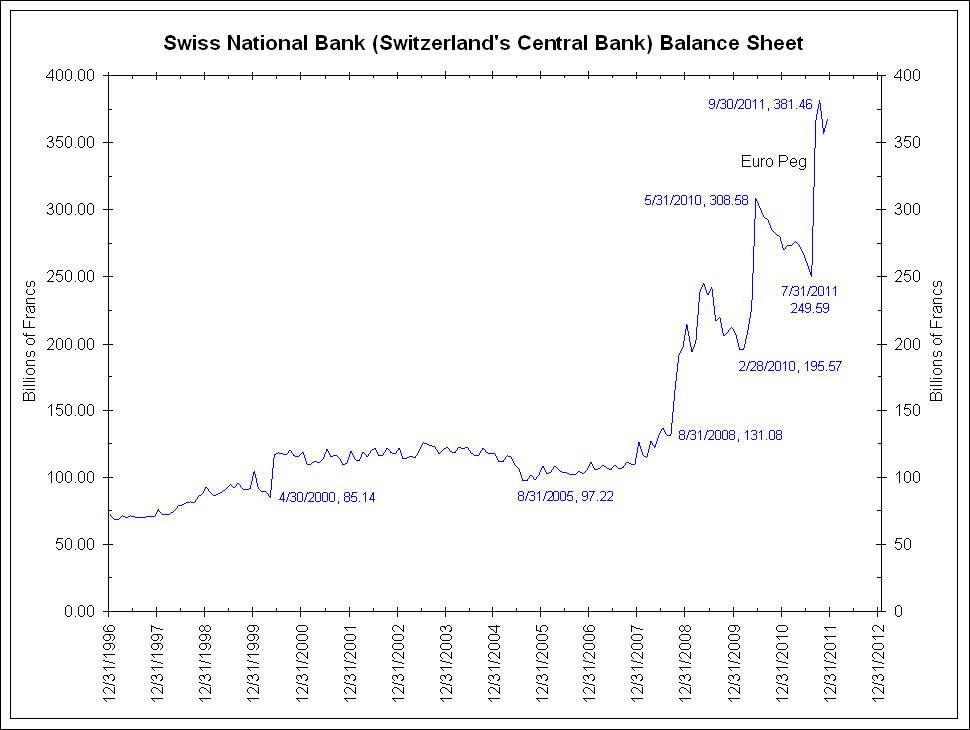
>
Comparing Central Bank Balance Sheets
For comparison's sake, we converted the eight balance sheets above into dollar terms. The four largest, the PBoC, the Fed, the BoJ and the ECB are shown in the first chart below. The second four, the Bundesbank, Banque de France, the BoE and SNB are shown in the second chart below. We split them up because of their vastly different scales.
In the first chart, note that the balance sheets of the PBoC and the ECB are larger than the Federal Reserve when converted to dollars. The BoJ used to be the largest balance sheet in dollar terms until 2006.
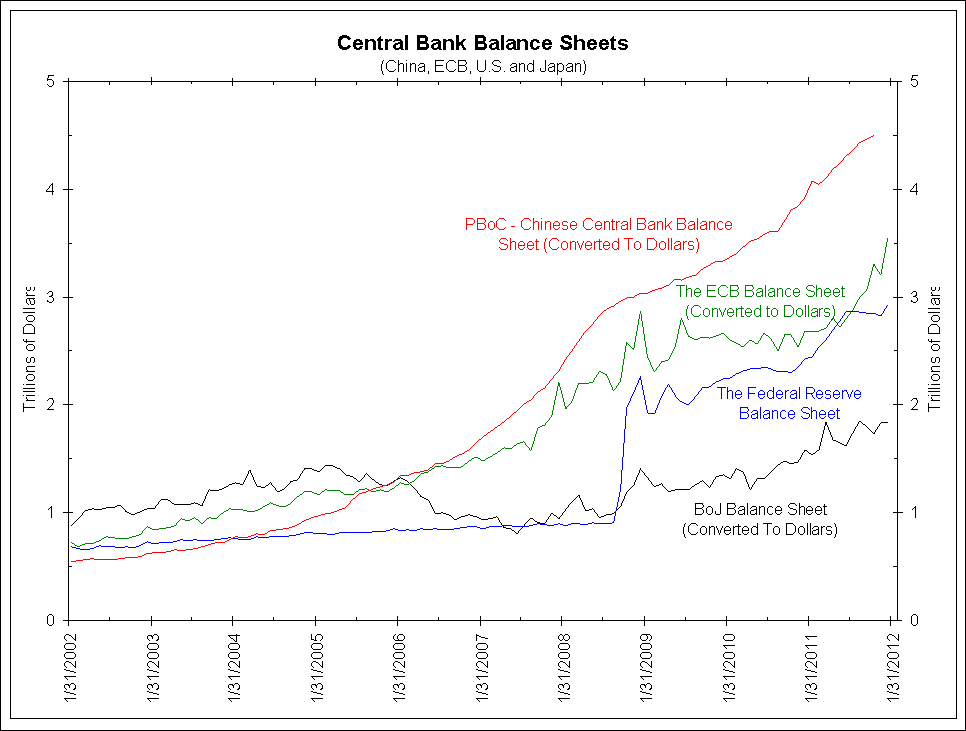
When shown in dollar terms below, the Bundesbank is the largest of the "second four" central banks. Further, its growth rate over the last five years has been among the highest. This is surprising since the Bundesbank is considered the "hard money" central bank.

Combining Central Bank Balance Sheets
The next chart below adds up the eight largest central bank balance sheets in dollar terms. It is only current through October as that is the latest number from the PBoC.
The combined size of these eight central banks' balance sheets has almost tripled in the last six years from $5.42 trillion to more than $15 trillion and is still on the rise!
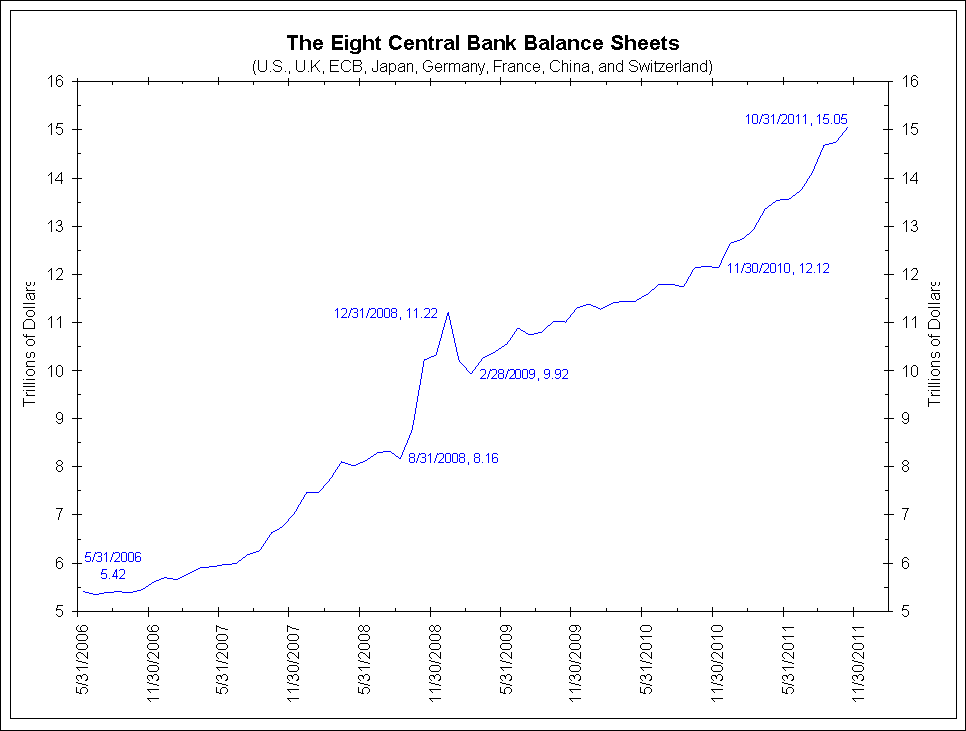
Central Banks Equal To One-Third Of World Equity Values
As noted above, QE is an expanding of balance sheets via increasing bank reserves. The purpose of QE, as explained by this Bank of England video, is to increase bank reserves through purchases of fixed income securities in order to lower interest rates. This makes fixed income securities relatively unattractive/overvalued and pushes investors out the risk curve. This should increase buying for riskier assets such as stocks, pushing them higher in price. Theoretically these higher prices should lead to a wealth effect and increased economic activity.
Given this definition and purpose, it is fair to compare the size of these balance sheets (now $15 trillion) to the capitalization of the world's stock markets (now $48 trillion). This is shown in the chart below.
Prior to the 2008 financial crisis, the eight central bank balance sheets were less than 15% the size of world stock markets and falling. In the immediate aftermath of Lehman Brothers' failure, these eight central bank balance sheets swelled to 37% the capitalization of the world stock market. But keep in mind that the late 2008/early 2009 peak was due to collapsing stock market values combined with balance sheet expansion via "lender of last resort" loans.
Recently, the eight central bank balance sheets have spiked back to 33% of world stock market capitalization. This has come about not by lender of last resort loans, but rather by QE expansion (buying bonds with "printed money") even faster than world stock markets are rising.
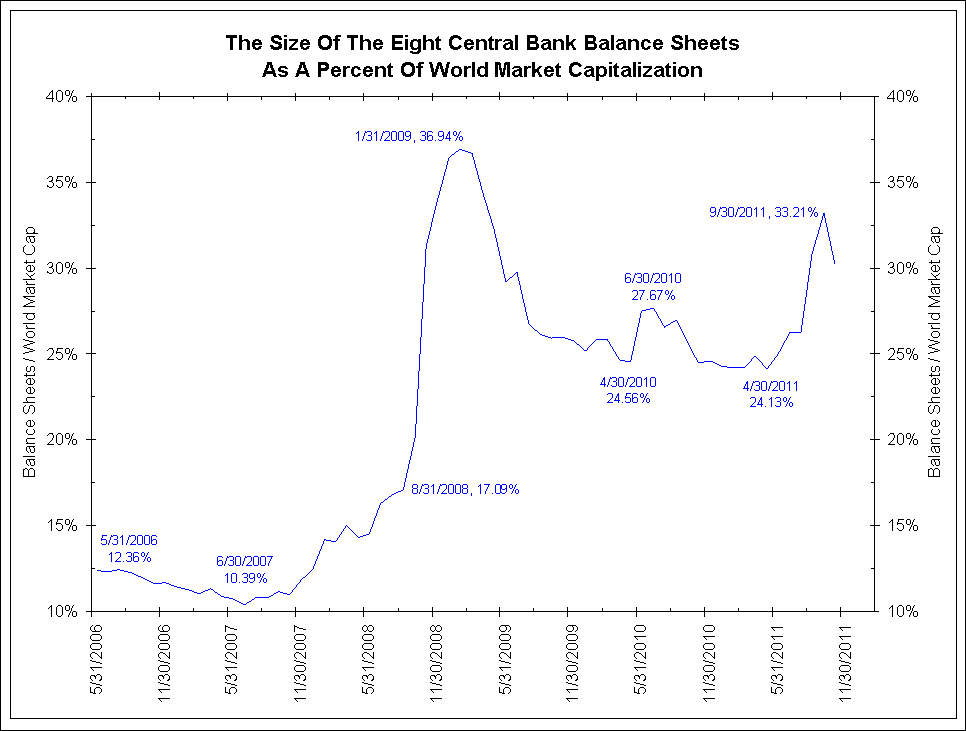
What Does It All Mean?
In our conference call earlier this month we said (page 12):
2011 was so difficult because all stocks seemingly moved together. It was as if every S&P 500 company had the same chairman of the board that knew only one strategy, resulting in a high degree of correlation between seemingly unrelated companies.
Massive central bank involvement in the markets risks returning us to a de facto centrally planned economy. Those S&P 500 companies all have the same chairman; it is Ben Bernanke because his policies are affecting everybody. That is what makes money management so difficult. Correlations will ebb and flow; they always do. But what makes them go away? This will only happen when governments and central banks go away.
But if they go away, then does that not mean things get ugly? Maybe they do get ugly, but it also means that we sort out the excesses in the market. We reward the people that do the right thing and we punish the people that do the wrong thing. And we have an adjustment process that may be ugly, but then we have a period of long expansion.
Central banks are ruling markets to a degree this generation has not seen. Collectively they are printing money to a degree never seen in human history.
So how does this process get reversed? How do central banks pull back trillions of dollars of money printing without throwing markets into a tailspin? Frankly, no one knows, least of all central banks as they continue to make new money printing records.
Until a worldwide exit strategy can be articulated and understood, risk markets will rise and fall based on the perceptions and realities of central bank balance sheets. As long as this is perceived to be a good thing, like perpetually rising home prices were perceived to be a good thing, risk markets will rise.
When/If these central banks go too far, as was eventually the case with home prices, expanding balance sheets will no longer be looked upon in a positive light. Instead they will be viewed in the same light as CDOs backed by sub-prime mortgages were when home prices were falling. The heads of these central banks will no longer be put on a pedestal but looked upon as eight Alan Greenspans that caused a financial crisis.
The tipping point between balance sheet expansion being bullish for risk assets versus bearish is impossible to know. Given the growth rate of central bank balance sheets around the world over the past few years, we might not have to wait too long to find out. Enjoy it while it is still bullish.


